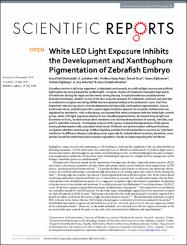| dc.contributor.author | Üstündağ, Ünsal Veli | |
| dc.contributor.author | Çalışkan-Ak, Esin | |
| dc.contributor.author | Ateş, Perihan Seda | |
| dc.contributor.author | Ünal, İsmail | |
| dc.contributor.author | Eğilmezer, Gizem | |
| dc.contributor.author | Yiğitbaşı, Türkan | |
| dc.contributor.author | Alturfan, Ahmet Ata | |
| dc.contributor.author | Emekli-Alturfan, Ebru | |
| dc.date.accessioned | 2020-02-27T14:22:44Z | |
| dc.date.available | 2020-02-27T14:22:44Z | |
| dc.date.issued | 2019 | en_US |
| dc.identifier.citation | Üstündağ, Ü. V., Çalışkan-Ak, E., Ateş, P. S., Ünal, İ., Eğilmezer, G., Yiğitbaşı, T. ... Emekli-Alturfan, E. (2019). White LED light exposure inhibits the development and xanthophore pigmentation of zebrafish embryo. Scientific Reports, 9(1). http://doi.org/10.1038/s41598-019-47163-y | en_US |
| dc.identifier.issn | 2045-2322 | |
| dc.identifier.uri | http://doi.org/10.1038/s41598-019-47163-y | |
| dc.identifier.uri | https://hdl.handle.net/20.500.12511/4973 | |
| dc.description.abstract | Circadian rhythm in all living organisms is disturbed continuously by artificial light sources and artificial lighting has become a hazard for public health. Circadian rhythm of melatonin maintains high levels of melatonin during the night and low levels during the day. N-acetyltransferase (arylalkylamine N-acetyltransferase, AANAT) is one of the four enzymes required for melatonin synthesis and mtnr1ba is a melatonin receptor-encoding mRNA that is expressed widely in the embryonic brain. Pax7 has important roles during neural crest development and especially xanthophore pigmentation. Due to its diurnal nature, zebrafish provide a special opportunity for research on circadian rhythms that are regulated by melatonin. Here in this study, we showed that when compared with the white light control group, white LED light exposure resulted in loss of yellow pigmentation, decreased body length and locomotor activity, oxidant-antioxidant imbalance and decreased expressions of aanat2, mtnr1ba, and pax7 in zebrafish embryos. Histological analysis of this group revealed disorganization of the spaces among photoreceptor cells, decreased total retinal thickness and photoreceptor cell layer thickness compared with the control group. Artificial lighting pollution has the potential to become an important risk factor for different diseases including cancer especially for industrialized countries, therefore, more studies should be performed and necessary regulations should be made regarding this risk factor. | en_US |
| dc.language.iso | eng | en_US |
| dc.publisher | Nature Publishing Group | en_US |
| dc.rights | info:eu-repo/semantics/openAccess | en_US |
| dc.rights | Attribution 4.0 International | * |
| dc.rights.uri | https://creativecommons.org/licenses/by/4.0/ | * |
| dc.subject | Development | en_US |
| dc.subject | Xanthophore Pigmentation | en_US |
| dc.subject | Zebrafish | en_US |
| dc.subject | White LED Light Exposure | en_US |
| dc.title | White LED light exposure inhibits the development and xanthophore pigmentation of zebrafish embryo | en_US |
| dc.type | article | en_US |
| dc.relation.ispartof | Scientific Reports | en_US |
| dc.department | İstanbul Medipol Üniversitesi, Tıp Fakültesi, Temel Tıp Bilimleri Bölümü, Tıbbi Biyokimya Ana Bilim Dalı | en_US |
| dc.authorid | 0000-0003-0804-1475 | en_US |
| dc.authorid | 0000-0002-0675-1839 | en_US |
| dc.identifier.volume | 9 | en_US |
| dc.identifier.issue | 1 | en_US |
| dc.relation.publicationcategory | Makale - Uluslararası Hakemli Dergi - Kurum Öğretim Elemanı | en_US |
| dc.identifier.doi | 10.1038/s41598-019-47163-y | en_US |
| dc.identifier.wosquality | Q1 | en_US |
| dc.identifier.scopusquality | Q1 | en_US |



















